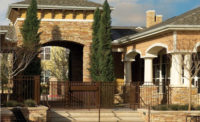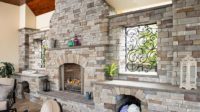For many decades, plasterers have applied the familiar finishes—skip trowel, smooth, sand, faux wood and stone, dash etc. In the past when a stucco or EIFS cladding was specified, along with a wainscot of stone or brick as a two-component façade, the two were treated as separate components applied by two trades. It was a familiar dance: The masons would lay-in the asphalt paper, put up some lath or ties, and erect a stone or brick wall. Then the plastering contractor would continue with the stucco or EIFS cladding. Looked good in the end but usually included some scheduling and territorial acrobatics. That is to say, which goes first? How do we make the WRB continuous? Darn plasterers, darn masons.
A little over a decade ago, a new façade stone and brick product became very popular which we know as manufactured stone. This was a lightweight product that was made to look like real stone, was usually made from cement, and was typically adhered to a given substrate. Many types of products were used to adhere the new lightweight product, ranging from stucco, type S or N cement mixes, or thin-set type adhesives. In the beginning, the manufactured stone folks tried to keep in line with what-was-always-done, that is, the product was applied by masons.
A Found Niche Service
Now, I have always maintained that plasterers are one of the most versatile groups in the wall and ceiling trades—just ask a plasterer and he’ll tell you just how smart he is. Well, seeing how the new manufactured stone market was impinging on the flow of the façade installations, plastering contractors ventured into the application of manufactured stone trade. They saw manufactured stone as a complementary niche market to their stucco business.
A plastering contractor from Utah that I know saw the opportunity of applying the stone and brick cement products. He became frustrated with the quality and ordering time frames of the then available products, and started manufacturing his own product. He is now a manufacturer and applicator. My brother, remember the stubborn one who got us pumping EIFS, used to use a pump to place faux stone. He would apply the WRB and lath and lay down a scratch coat and cure it properly. Then he would bring the pump and spray a heavy layer of cement over the scratch coat. His crew would follow placing rocks and scoring around them with tools to make a finished stone surface; fast and easy was his credo.
But, all manufactured stones are not created equal. Tim, a longtime friend and owner of Volterrra Architectural Products, gave me the rundown on manufacturing. The secret to a long-lasting and real looking stone is to use a good mix and the proper mold. There are four basic types of molds: silicone, urethane, latex (the most popular) and plastisol (the most economical). The most realistic manufactured stones are made using silicone molds which are the most expensive. When making the molds, silicone flows more readily around the real stone for a more detailed texture, one that truly mimics the fine crevices we see in stone. When it comes to the coloring, a manufacturer can use a liquid or dry pigment. It is the process of “painting” the molds with varying colors and having the color release from the mold that lends to a quality, realistic look.
Silicone molds release all of the manufactured stone including color residues allowing for consistent multiple runs. Finally, like any cement mixture, it is the combinations and ratios of the mix that ultimately lead to long term weatherability and maintaining that looks-just-like-a-real-stone look. Cement and aggregates, both lightweight and gravel sized, make up the bulk of the mix. Special additives can then be added to allow for water and/or air entrainment or to vary the tensile and compressive strengths or to enhance weatherability in special climates.
In framed exterior wall construction, the manufactured stone or brick components are applied to a scratch coat, the same as in a stucco assembly. As we know, with any exterior cladding over framed wall construction, a continuous water resistive barrier is key to maintaining the integrity of the assembly. So having one contractor, the plastering contractor, install all of the components creates a continuous, single-source cladding assembly, one finished with differing components. Because the stone façade is cemented to a continuous lath and scratch coat, there is no need for a metal flashing between the stucco/EIFS and façade material, one can simply use a sealant to function as a moveable component between the differing claddings. You see, the whole wall is functioning as a single clad entity—it doesn’t know there are two different finish components.
When Used with EIFS
When manufactured stone is used in conjunction with a full EIF system, considerations to application must be made. One cannot adhere manufactured stone or brick products directly to the foam, basecoat and mesh. The foam and lamina layer are not engineered to hold the weight of the manufactured cement façade components. A separate lath and base for the manufactured stone must be installed. (All of the EIFS manufacturers do have an acrylic finish process available for a look which successfully replicates brick, but the stone look is a bit more challenging to achieve.)
When an EIF system is applied, the contractor must be cognizant of the interface or transition between the two claddings. Sometimes it is necessary to install a flashing between the two facades, or possibly a drainage component at the bottom of the EIF system. A single continuous WRB is achievable with a little forethought and planning. Your EIFS manufacturer or technical association can assist you with this detail.
As with all of our other building components, technology can enhance product performance. A noted performance challenge of manufactured stone products is the delamination or “pop-off” of the stone product. Like any exterior cladding, quality of workmanship and proper product selection are key. With manufactured stone, the non-grouted or dry-stack look has experienced some delamination issues (simply, the adhesive and basecoat products didn’t form a complete bond). This delamination event also happened in grouted versions of brick and stone but to a lesser degree.
SPEC-MIX, a division of QUIKRETE, developed a solution, manufacturing a technologically advanced formulation for this cladding component. Polymer modified stone veneer mortar was invented to address this very issue. It is a dry, pre-blended mix of cementious products, aggregates and proprietary admixtures. It works like a good stucco mix but is specifically designed for manufactured veneer products. One more consideration: It is important that the mortar and stone be of similar composition, that is, the bond strength of the mortar should be similar to the tensile strength of the stone.
Quality components and ingredients in manufactured stone products contribute to the long lasting aesthetic appeal of a manufactured, realistic stone look. The selection of a proven specialty mortar and grout mix contributes to this, and the knowledge of a good plastering contractor familiar with proper application of a WRB and lath assembly completes the façade ensemble.









